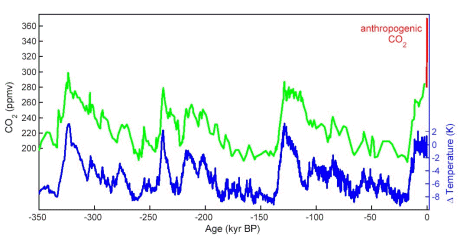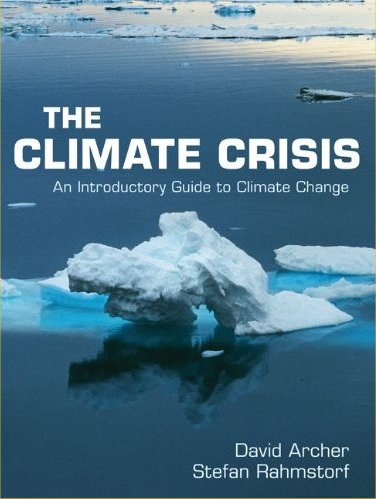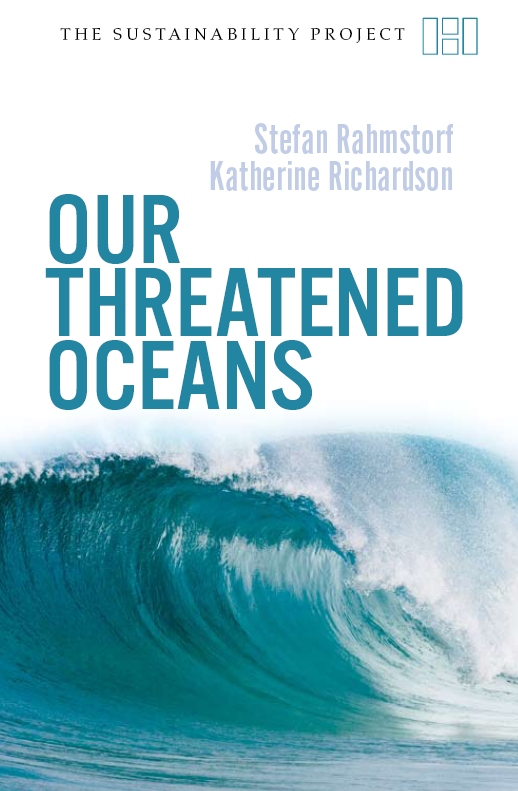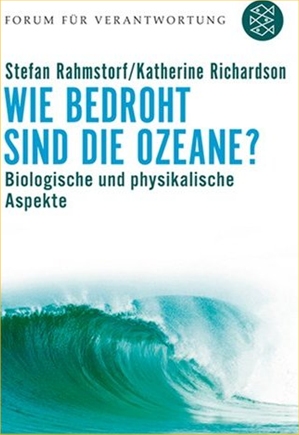Article published on 27 January 2004 in Eos, Transactions of the American Geophysical Union
Cosmic Rays, Carbon Dioxide and Climate
Stefan Rahmstorf 1, David Archer 2, Denton S. Ebel 3, Otto Eugster 4, Jean Jouzel 5, Douglas Maraun6, Urs Neu7, Gavin A. Schmidt 8, Jeff Severinghaus9, Andrew J. Weaver 10 and Jim Zachos 11
Several recent papers
have applied correlation analysis to climate-related time series
in the hope of finding evidence for causal relationships. For a
critical discussion of correlations between solar variability, cosmic
rays and cloud cover see [Laut, 2003].
A prominent new example is
a paper by [Shaviv and Veizer, 2003], which claims that fluctuations
in cosmic ray flux reaching the Earth can explain 66% of the temperature
variance over the past 520 million years (520 m.y.), and that the
sensitivity of climate to a doubling of CO2 is smaller
than previously estimated.
Shaviv and Veizer’s paper was accompanied by a press release
titled “Global warming not a man-made phenomenon”, in
which Shaviv is quoted stating: “The operative significance
of our research is that a significant reduction of the release of
greenhouse gases will not significantly lower the global temperature,
since only about a third of the warming over the past century should
be attributed to man”.
We here present a critical appraisal of the methods and conclusions
of [Shaviv and Veizer, 2003].
Reconstructing cosmic ray
fluxes
The starting point of [Shaviv and Veizer,
2003] is a reconstruction of cosmic ray fluxes over the past 1,000
m.y. based on 50 iron meteorites and a simple model estimating cosmic
ray flux (CRF) induced by the Earth's passage through Galactic spiral
arms ([Shaviv, 2002; Shaviv, 2003]). About 20 of the meteorites,
making four clusters, date from the past 520 m.y., the time span
analysed in [Shaviv and Veizer, 2003]. The meteorites are dated
by analysing isotopic changes in their matter due to cosmic ray
exposure (CRE dating [Eugster, 2003]). An apparent age clustering
of these meteorites is then interpreted not as a collision-related
clustering in their real ages but as an indication of fluctuations
in cosmic ray flux.
One difficulty with this interpretation is that variations in CRF
intensity would equally affect all types of meteorites. Instead,
the ages of different types of iron meteorites cluster at different
times [Wieler, 2002]. Hence, most specialists on meteorite CRE ages
interpret the clusters as the result of collision processes of parent
bodies, as they do for stony meteorites (ages < 130 m.y.) to
which more than one dating method can be applied.
Another problem of the CRF reconstruction is the presumption of
"periodicity" of the clusters. The time spans between
the clusters' gaps, which correspond to high CRF in their theory,
are roughly 90, 90, 140, 130, 190, 140 m.y. (Fig. 4 of [Shaviv,
2003]). The claim that these data support a periodicity of 143±10
m.y. seems not obvious. The passage through the four galactic arms
should be a regular process; the high variability of the age gaps
is not addressed.
The CRF model is based on the assumption that cosmic ray density
should be concentrated in the Galactic spiral arms, with a time
lag of peak CRF of about 15 m.y. behind the spiral arm passage.
CRF is computed by a simple diffusion model with several free parameters.
These parameters are constrained by 'observational constraints’,
including the meteorite data. These constraints are very weak; the
crucial cosmic ray diffusion coefficient can only be constrained
to within two orders of magnitude.
Moreover, even the best-fit CRF model does not fit the meteorite
data well. For the time span analysed in [Shaviv and Veizer, 2003],
the cluster gaps are located near 100 m.y., 190 m.y., 280 m.y. and
420 m.y. BP (Fig. 4 of [Shaviv, 2003]); they are supposed to coincide
with CRF maxima which the ‘best fit’ model locates at
about 30 m.y., 170 m.y., 360 m.y. and 470 m.y. BP. This is hardly
a good agreement, with an rms deviation of 60 m.y. Agreement of
the three CRF minima (at ~80 m.y., 250 m.y., 420 m.y. BP) with the
age clusters (at ~140 m.y., 250 m.y., 360 m.y. BP) is hardly better,
with two of the three clusters off by almost half a period. The
only apparent similarity between the CRF model and the meteorite
data is the average of the periods. The large uncertainty about
the timing of spiral arm crossings and the associated CRF maxima
is corroborated by the fact that another recent paper ([Leitch and
Vasisht, 1998]), which uses the spiral arm crossings to explain
biological extinctions, places these crossings at completely different
times.
The final parameter choice of the CRF model shown in Fig. 10 of
[Shaviv, 2003] is that “which best fits the ice age epochs”,
i.e., the cosmic ray model has already been fitted to climate data.
This circular reasoning compromises the significance of any subsequent
correlation with climate data.
Correlating cosmic ray fluxes
to surface temperature
Next, [Shaviv and Veizer,
2003] correlate a CRF reconstruction with a reconstruction of sea
surface temperature based on oxygen isotope data from calcite shells
from various low-latitude sites. The temperature proxy data were
detrended and smoothed with a 50 m.y. window to emphasise variations
on the ~150 m.y. period of the CRF model. The CRF model used in
[Shaviv and Veizer, 2003] (shown in Fig. 2 of [Shaviv and Veizer,
2003] as a blue line) is not the same as either of the two different
CRF curves shown in [Shaviv, 2003], even though this publication
is given as its source. The CRF curves shown in Fig. 7 and Fig.
10 of [Shaviv, 2003] have a CRF maximum near 360 m.y., while that
shown in [Shaviv and Veizer, 2003] has a maximum near 320 m.y. [Shaviv,
2003] argues that such a shift of this peak is within the observational
uncertainty of the position of the Norma Galactic spiral arm and
would “increase the agreement” with climate data.
[Shaviv and Veizer, 2003] then arbitrarily change the time scale
in the reconstruction to obtain yet another CRF curve (the red curve
in Fig. 2 of [Shaviv and Veizer, 2003]), which they call “fine
tuned to best fit the low-latitude temperature”. This third
tuning step shifts the third CRF maximum by another ~20 m.y. to
near 300 m.y. This CRF maximum has thus been shifted by ~60 m.y.,
almost half a period, compared to those shown in [Shaviv, 2003].
The correlation between this final cosmic ray
curve and the temperature record is r = 0.81 for an “explained
variance” of 66%. However, the CRF curve before this final
“fine-tuning” (i.e., the less-tuned blue curve in Fig.
2 of [Shaviv and Veizer, 2003]) explains only 30% of the variance,
which is statistically indistinguishable from zero.
We thus find that there is no significant correlation of the CRF
curve from Shaviv’s model and the temperature curve of Veizer,
even after one of the four CRF peaks was arbitrarily shifted by
40 m.y. to improve the fit to the temperature curve. There also
is no significant correlation between the original meteorite data
and the temperature reconstruction. The explained variance claimed
by [Shaviv and Veizer, 2003] is the maximum achievable by optimal
smoothing of the temperature data and by making several arbitrary
adjustments to the cosmic ray data (within their large uncertainty)
to line up their peaks with the temperature curve.
Regression of CO2 and temperature
The final argument of [Shaviv and Veizer, 2003] – that CO2 has a smaller effect on climate than previously thought – is based on a simple regression analysis of smoothed temperature and CO2 reconstructions. [Shaviv and Veizer, 2003] conclude that the effect of a doubling of atmospheric CO2 concentration on tropical sea surface temperatures (SST) is likely to be 0.5ºC (up to 1.9ºC at 99% confidence), with global mean temperature changes about 1.5 times as large. Thus they claim that the climate sensitivity to 2xCO2 is around 0.75 ºC, outside the Intergovernmental Panel on Climate Change range of 1.5-4.5ºC (misquoted as 5.5ºC in [Shaviv and Veizer, 2003]) [IPCC, 2001]. Note, however, that their maximum global sensitivity of 2.9ºC lies well within the accepted range.
A critique of the CO2
and temperature reconstructions used in [Shaviv and Veizer, 2003]
will be published by Royer et al [in press], who correct Veizer’s
d18O record for the effect of changing pH. This effect has been
demonstrated in culture [Spero et al., 1997] and explained theoretically
[Zeebe, 1999; Zeebe, 2001]. The result is a corrected climate record
that no longer follows the cosmic ray model but correlates well
with the Geocarb III CO2 reconstruction.
[Shaviv and Veizer, 2003] challenge the credibility of the CO2
reconstructions by showing two divergent alternatives to the well-known
Geocarb III model, by U. Berner (not documented in the scientific
literature) and by [Rothman, 2002]. [Shaviv and Veizer, 2003] argue
that the disagreement between the reconstructions reveals them to
be in need of „validation“, but ignore the large literature
of paleosol, stomatal, and carbon and boron isotopic data, which
support the Geocarb reconstruction [Royer et al, in press].
Irrespective of the data quality,
the simple regression method of [Shaviv and Veizer, 2003] is unsuitable
to estimate the climate sensitivity to a CO2 doubling.
The main reasons are that (i) other forcing and feedback factors
may co-vary in a statistically dependent way with CO2
and cannot be separated, (ii) the operation of some climate feedbacks
depends on the time scale considered, and (iii) the strength of
climate feedbacks depends on the mean climate.
Over a decade ago, [Lorius et al., 1990] used the high-quality records
of temperature and CO2 variations from ice cores (Fig.
1) to derive information on climate sensitivity. These authors had
reliable data available and carefully considered the above caveats.
Concerning (i), [Lorius et al., 1990] recognised that CO2
and methane concentrations co-vary, so that only the joint effect
of both gases can be derived by regression. They accounted for the
known orbital forcing and also considered other possible feedbacks,
such as the aerosol loading of the atmosphere. They further distinguished
slow and fast feedbacks (caveat (ii)). The growth and decay of continental
ice sheets represents a slow feedback operating over millennia;
if one is concerned with the more rapid response of the climate
to CO2, ice sheets have to be accounted for as a major
forcing.

Figure 1. Records of CO2 (green) and temperature (blue) over the past 350,000 years from the Vostok ice core, after [Petit et al., 1999]. Part of these data were used by [Lorius et al., 1990] to estimate climate sensitivity. The recent anthropogenic rise in CO2 ([IPCC, 2001]) is marked in red.
In contrast, [Shaviv and Veizer, 2003] accounted for none of these
caveats. Concentrations of other greenhouse gases, which may have
co-varied with CO2 on the multi-million-year time scale,
are not known, and neither is the aerosol loading of the atmosphere
or the external forcing of the climate changes on this time scale.
Likewise, it is not known which physical, geochemical or biological
feedbacks may operate, and at what magnitude, on such long time
scales.
[Lorius et al., 1990] concluded from their analysis that climate
sensitivity to a doubling of CO2 is 3-4ºC, in good
agreement with independent estimates based on the physical understanding
of CO2 forcing and relevant feedbacks as coded in models.
Note that the primary driver of glacial cycles is the Milankovich
orbital forcing while CO2 acts as an amplifying feedback;
this in no way questions the effect of CO2 on temperature.
The dependence of climate sensitivity on the mean state (caveat
(iii)) cannot be avoided, but it is a more serious problem for the
time period considered by [Shaviv and Veizer, 2003] with conditions
very different from the modern climate system. Positions of continents
shifted, ocean currents took a different course, and estimated CO2
levels were between twice and ten times of present values during
most of this time. Little is known about the feedbacks operating
on these time scales and for high CO2 climates. There
are good reasons to assume that important amplifying feedbacks,
such as the snow albedo feedback, become much weaker in warmer climates,
which would result in an underestimation of climate sensitivity
to CO2 doubling in such a regression.
Conclusions
Two main conclusions result from our analysis of
[Shaviv and Veizer, 2003]. The first is that the correlation of
cosmic ray flux (CRF) and climate over the past 520 m.y. appears
to not hold up under scrutiny. Even if we accept the questionable
assumption that meteorite clusters give information on CRF variations,
we find that the evidence for a link between CRF and climate amounts
to little more than a similarity in the average periods of the CRF
variations and a heavily smoothed temperature reconstruction. Phase
agreement is poor. The authors applied several adjustments to the
data to artificially enhance the correlation. We thus find that
the existence of a correlation has not been convincingly demonstrated.
Our second conclusion is independent of the first. Whether there
is a link of CRF and temperature or not, the authors’ estimate
of the effect of a CO2-doubling on climate is highly
questionable. It is based on a simple and incomplete regression
analysis which implicitly assumes that climate variations on time
scales of millions of years, for different configurations of continents
and ocean currents, for much higher CO2 levels than at
present, and with unaccounted causes and contributing factors, can
give direct quantitative information about the effect of rapid CO2
doubling from pre-industrial climate. The complexity and non-linearity
of the climate system does not allow such a simple statistical derivation
of climate sensitivity without a physical understanding of the key
processes and feedbacks. We thus conclude that [Shaviv and Veizer,
2003] provide no cause for revising current estimates of climate
sensitivity to carbon dioxide.
References
Eugster, O., Cosmic-ray exposure ages
of meteorites and lunar rocks and their significance, Chemie der
Erde, 63, 3-30, 2003.
IPCC, Climate Change 2001, Cambridge University Press, Cambridge,
2001.
Laut, P., Solar activity and terrestrial climate: an analysis of
some purported correlations, Journal of Atmospheric and Solar-Terrestrial
Physics, 65, 801– 812, 2003.
Leitch, E.M., and G. Vasisht, Mass extinctions and the sun's encounters
with spiral arms, New Astronomy, 3, 51-56, 1998.
Lorius, C., J. Jouzel, D. Raynaud, J. Hansen, and H. Le Treut, The
ice-core record: climate sensitivity and future greenhouse warming,
Nature, 347, 139-145, 1990.
Petit, J.R., et al., Climate and atmospheric history of the past
420,000 years from the Vostok ice core, Antarctica, Nature, 399,
429 - 436, 1999.
Rothman, D.H., Atmospheric carbon dioxide levels for the last 500
million years, Proceedings of the National Academy of Science of
the USA, 99, 4167-4171, 2002.
Royer, D.L., R.A. Berner, I.P. Montañez, N.J. Tabor, and
D.J. Beerling, CO2 as a primary driver of Phanerozoic
climate, GSA Today, in press.
Shaviv, N., Cosmic ray diffusion from the galactic spiral arms,
iron meteorites, and a possible climate connection?, Physical Review
Letters, 89, 051102, 2002.
Shaviv, N., The spiral structure of the Milky Way, cosmic rays,
and ice age epochs on Earth, New Astronomy, 8, 39-77, 2003.
Shaviv, N., and J. Veizer, Celestial driver of Phanerozoic climate?,
GSA Today, 13 (7), 4-10, 2003.
Spero, H.J., J. Bijma, D.W. Lea, and B.E. Bemis, Effect of seawater
carbonate concentration on foraminiferal carbon and oxygen isotopes,
Nature, 390, 497-500, 1997.
Wieler, R., Cosmic-ray produced noble gases in meteorites, in Noble
Gases in Geochemistry and Cosmochemistry, edited by D. Porcelli,
C.J. Ballantine, and R. Wieler, pp. 125-170, 2002.
Zeebe, R.E., An explanation of the effect of seawater carbonate
concentration on foraminiferal oxygen isotopes, Geochimica Cosmochimica
Acta, 63, 2001-2007, 1999.
Zeebe, R.E., Seawater pH and isotopic paleotemperatures of Cretaceous
oceans, Palaeogeography, Palaeoclimatology, Palaeoecology, 170,
49-57, 2001.
Author affiliations
- Potsdam Institute for Climate Impact Research, Potsdam, Germany.
- Department of Geophysical Sciences, University of Chicago, Chicago, Illinois, USA
- Department of Earth and Planetary Science, American Museum of Natural History, New York, New York, USA
- Department of Space Research and Planetology, Physics Institute, University of Bern, Bern, Switzerland
- Institut Pierre Simon Laplace /LSCE, Saclay, France
- Institute of Physics, Potsdam University, Potsdam, Germany
- ProClim, Swiss Forum for Climate and Global Change, Swiss Academy of Sciences, Bern, Switzerland
- NASA Goddard Institute for Space Studies and Columbia University Center for Climate Systems Research, New York, New York, USA
- Geoscience Research Division, Scripps Institution of Oceanography, La Jolla, California, USA
- School of Earth and Ocean Sciences, University of Victoria, Victoria, British Columbia, Canada
- Center for the study of the Dynamics and Evolution of the Land-Sea Interface, University of California, Santa Cruz, California, USA
Links
A related statement by 14 Swiss and German scientists can be found at www.pik-potsdam.de/news/discussion/pm_Shaviv_Veizer_e.html
The response by Shaviv and Veizer can be found at www.pik-potsdam.de/news/discussion/discussion.html













